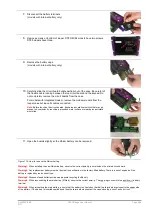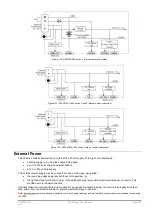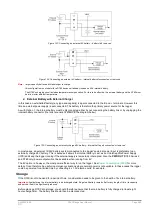
UM-0085-B09
DT80 Range User Manual
Page 296
RG
Example 1
A DT85 is powered by an external 12V supply, is running a 10 second schedule with 5 analog channels, and the
12V
power output is enabled with a 200mW load connected. The Ethernet port is disabled.
Using
, the average power consumption for the core hardware is 420mW. We now need to add the power used
by the
12V
power output (550+200 = 750mW, from
). But from Table 16, the logger spends only 10% of its time
awake, so this hardware module will, on average, contribute 750 x 10% = 75mW. The overall average power
consumption is therefore 420 + 75 = 495mW.
Example 2
A remote monitoring station consists of a DT80L measuring and logging 10 analog channels and 5 digital channels every
5 minutes. It is powered by a 12V solar-charged battery. The Ethernet port is disabled.
Using
, we need to interpolate between the 5 and 30 analog channel columns, and between the 1 and 10 minute
schedule rate rows. So we estimate 16 mW average power usage for a 5 minute schedule. Note that we can disregard
the digital channel measurements as the power usage will be negligible compared to the analog channels. We also
assume that Ethernet and the LCD backlight will be disabled, so there is no extra power usage there.
The solar panel and external battery can now be sized based on these calculated power requirements (16 mW average).
The power system (i.e. the external battery) will also need to be able to handle the peak power demand, which can be
calculated by adding up the worst case instantaneous consumption figures: 1300mW (core hardware, active power state)
+ analog subsystem (650 mW). This works out to around 2W, or 200 mA @ 12V.
Example 3
A DT85 is powered by an external 12V supply and is set up to poll a network of SDI-12 sensors every 5 minutes. It takes
a total of 30 seconds to power up and read all of the sensors. The SDI-12 network is powered by the DT85's switched
12V
output, and draws a total of 800 mW. The Ethernet port is disabled.
In this case we cannot just look up the average power consumption for a 5 minute schedule with zero analog channels,
because the long SDI-12 measurement will keep the logger awake for much longer.
Instead, we need to estimate how long the logger is spending in each of its power states. In this case:
•
allow 2 seconds for the logger to wake up and do the actual SDI-12 communications, logging, etc. (active power
state)
•
allow 30 seconds of doing nothing waiting for the sensors to return values (idle power state)
•
and sleep for the remaining 4 minutes and 28 seconds (268 seconds) (sleep power state).
The power consumption for each power state is listed in Table 9 – 1800, 500 and 60 mW for the active, idle and sleep
states respectively.
We also need to allow for the power drawn from the
12V
output terminal by the SDI-12 network, which will be 550 mW
for the power supply plus 800 mW for the load (1350 mW total). This power output will be active for 32 seconds.
So if we average the power consumption over the 5 minute (300 second) schedule interval:
𝐴𝑣𝑒
𝑃𝑜𝑤𝑒𝑟
= (1800 + 1350)
𝑚𝑊
𝑥
2
300 +
(500 + 1350)
𝑚𝑊
𝑥
30
300 + 60
𝑚𝑊
𝑥
268
300 = 260
𝑚𝑊
Example 4
80 thermocouples are connected to two CEM20 modules controlled by a DT80, and are measured once a minute. The
CEM20s are powered by the
DT80
's
12V
output. The Ethernet port is disabled.
CEM20 measurements take about twice as long as regular measurements, so this system is roughly equivalent to
sampling 160 analog channels. Using
, we estimate the average core hardware power drawn from an external
12V supply to be 300mW.
We now need to add the power used by the 12V output and the CEM20s, which will be 550+350 = 900mW, from Table
15. From Table 16, we estimate that the logger spends about 10% of its time awake, so the CEM20s will, on average,
contribute 900 x 10% = 90mW. The overall average power consumption is therefore approximately 300 + 90 = 390mW.
Example 5
A DT82EM3 powered by a 12V supply is set up to sample 2 analog channels every 10 seconds and transmit the
resulting data daily at 9am via modem to an FTP server. Ethernet is disabled. The modem is configured to stay online for
a minimum of 10 minutes during this process to allow the user to connect via
dEX
in case any maintenance is required.
In this example the modem is in an area with 3G network coverage.
Using
, we estimate the average core power consumption to be 120mW.
Based on the rule of thumb of 10 bytes per sample plus 10 per schedule iteration, a total of 24 x 60 x 6 x (10 + 2 x 10) =
260 kbytes of data. If the 3G data rate is, say, 15kbyte/s then the data will take about 17 seconds to transfer, which is
fairly negligible compared to the modem startup and network registration time (60s) plus the configured minimum session
time (10 minutes).
















































